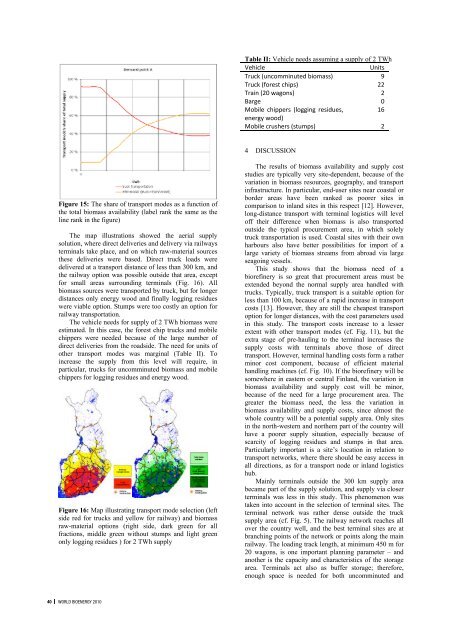Proceedings World Bioenergy 2010
Proceedings World Bioenergy 2010
Proceedings World Bioenergy 2010
Create successful ePaper yourself
Turn your PDF publications into a flip-book with our unique Google optimized e-Paper software.
Figure 15: The share of transport modes as a function of<br />
the total biomass availability (label rank the same as the<br />
line rank in the figure)<br />
The map illustrations showed the aerial supply<br />
solution, where direct deliveries and delivery via railways<br />
terminals take place, and on which raw-material sources<br />
these deliveries were based. Direct truck loads were<br />
delivered at a transport distance of less than 300 km, and<br />
the railway option was possible outside that area, except<br />
for small areas surrounding terminals (Fig. 16). All<br />
biomass sources were transported by truck, but for longer<br />
distances only energy wood and finally logging residues<br />
were viable option. Stumps were too costly an option for<br />
railway transportation.<br />
The vehicle needs for supply of 2 TWh biomass were<br />
estimated. In this case, the forest chip trucks and mobile<br />
chippers were needed because of the large number of<br />
direct deliveries from the roadside. The need for units of<br />
other transport modes was marginal (Table II). To<br />
increase the supply from this level will require, in<br />
particular, trucks for uncomminuted biomass and mobile<br />
chippers for logging residues and energy wood.<br />
Figure 16: Map illustrating transport mode selection (left<br />
side red for trucks and yellow for railway) and biomass<br />
raw-material options (right side, dark green for all<br />
fractions, middle green without stumps and light green<br />
only logging residues ) for 2 TWh supply<br />
40 world bioenergy <strong>2010</strong><br />
Table II: Vehicle needs assuming a supply of 2 TWh<br />
Vehicle Units<br />
Truck (uncomminuted biomass) 9<br />
Truck (forest chips) 22<br />
Train (20 wagons) 2<br />
Barge 0<br />
Mobile chippers (logging residues,<br />
energy wood)<br />
16<br />
Mobile crushers (stumps) 2<br />
4 DISCUSSION<br />
The results of biomass availability and supply cost<br />
studies are typically very site-dependent, because of the<br />
variation in biomass resources, geography, and transport<br />
infrastructure. In particular, end-user sites near coastal or<br />
border areas have been ranked as poorer sites in<br />
comparison to inland sites in this respect [12]. However,<br />
long-distance transport with terminal logistics will level<br />
off their difference when biomass is also transported<br />
outside the typical procurement area, in which solely<br />
truck transportation is used. Coastal sites with their own<br />
harbours also have better possibilities for import of a<br />
large variety of biomass streams from abroad via large<br />
seagoing vessels.<br />
This study shows that the biomass need of a<br />
biorefinery is so great that procurement areas must be<br />
extended beyond the normal supply area handled with<br />
trucks. Typically, truck transport is a suitable option for<br />
less than 100 km, because of a rapid increase in transport<br />
costs [13]. However, they are still the cheapest transport<br />
option for longer distances, with the cost parameters used<br />
in this study. The transport costs increase to a lesser<br />
extent with other transport modes (cf. Fig. 11), but the<br />
extra stage of pre-hauling to the terminal increases the<br />
supply costs with terminals above those of direct<br />
transport. However, terminal handling costs form a rather<br />
minor cost component, because of efficient material<br />
handling machines (cf. Fig. 10). If the biorefinery will be<br />
somewhere in eastern or central Finland, the variation in<br />
biomass availability and supply cost will be minor,<br />
because of the need for a large procurement area. The<br />
greater the biomass need, the less the variation in<br />
biomass availability and supply costs, since almost the<br />
whole country will be a potential supply area. Only sites<br />
in the north-western and northern part of the country will<br />
have a poorer supply situation, especially because of<br />
scarcity of logging residues and stumps in that area.<br />
Particularly important is a site’s location in relation to<br />
transport networks, where there should be easy access in<br />
all directions, as for a transport node or inland logistics<br />
hub.<br />
Mainly terminals outside the 300 km supply area<br />
became part of the supply solution, and supply via closer<br />
terminals was less in this study. This phenomenon was<br />
taken into account in the selection of terminal sites. The<br />
terminal network was rather dense outside the truck<br />
supply area (cf. Fig. 5). The railway network reaches all<br />
over the country well, and the best terminal sites are at<br />
branching points of the network or points along the main<br />
railway. The loading track length, at minimum 450 m for<br />
20 wagons, is one important planning parameter – and<br />
another is the capacity and characteristics of the storage<br />
area. Terminals act also as buffer storage; therefore,<br />
enough space is needed for both uncomminuted and









